Wild at heart
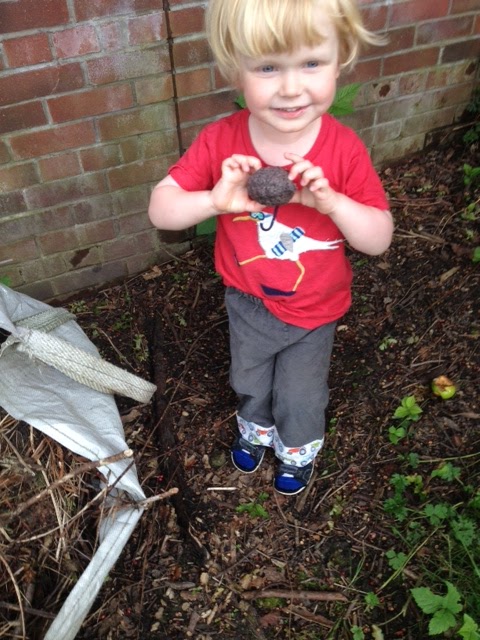
No it’s not poop! Read on to find out what Euan’s holding
The big picture
First of all we should also remember that the wildflowers themselves are part of our country’s heritage. Wildflowers aren’t just picnic sites for bees and butterflies to eat nectar or for birds to eat the seeds. But with plants and wildlife being so closely linked, if we help one, we help the other. As native plants and wild animals have grown up together over thousands and thousands of years they know each other really well and how best to live alongside each other. Some plant-eating insects only eat one type of plant (that’s a very boring diet) and it’s always a native one. The common blue butterfly only lays its eggs upon bird’s-foot trefoil or greater birds-foot trefoil. So if those plants disappear from our countryside the common blue butterfly will starve and become extinct. Have a look at this BBC video that shows brainy folk with more reasons why native wildflowers are the best.
The clever people at Plantlife are trying to encourage mother nature to regenerate her wildflower areas and colonise our countryside with native plants that would have been there in the past. They are trying to protect the pockets of wildflower populations that we still have so that the flowers can naturally spread to neighbouring areas. Plantlife help the flowers to spread by sowing locally collected seeds or spreading local soil that contains seeds. Even animals can help out as seeds can stick to the hairs of cows as they are moved between fields and to horses as they are ridden through the countryside. This sort of spread is what would have happened naturally in the past and the seeds have a greater chance of growing as they are well adapted to local weather and soil. If we can’t use these natural methods of spreading local seeds then it is time to turn to manual sowing of local seeds. But you need to make sure the seeds are from native plants and are suitable for your garden. Scotia Seeds is a reputable source of native wildflower seeds recommended by Plantlife. Remember to never, ever dig up plants from the wild as that is against the law.
What you can do
- Yellow rattle- great in a meadow
- Teasel- perfect in borders
- Red campion- loves woodland edges
- Waxcaps- pretty fungi found in meadows
- Lichens- happily covers walls, trees and rocks
- Daisies- makes for pretty lawns
- Ivy- low maintenance green walls
- Devil’s-bit scabious- loves meadows
- Nettles- some butterflies only lay their eggs on nettles
- Primroses- ants love to munch on their seeds
If you have a dry stane dyke in your garden why not fill a few of the holes with soil, sand or gravel in which wild flowers can grow? Harebells, saxifrages, herb robert and mosses and lichens would all love a home there as they’d think they were in the rocky outcrops they love in the wild.
You could grow meadowsweet in a wildlife pond area. Mummy and Daddy recently blogged how easy it is to make a pond in a small space (even in an old bucket!)
Plants to avoid
Every year us Brits spend 1.7 billion pounds trying to to get rid of invading non-native plants. So make sure not to plant them into your garden in the first place. Here is Plantlife’s list of the worst 12 plants and wildflowers that you can buy and plant, but shouldn’t:
- American Skink cabbage (sounds too smelly anyway!)
- Broad-leaved bamboo
- Chilean giant rhubarb
- Cotoneasters (only 1 type is native the other 70 are invaders)
- Himalayan balsam
- Hottentot fig (fab name for a bully of a plant!)
- Japanese knotweed (strong enough to grow through tarmac & concrete!)
- Pirri-pirri bur
- Rhododendron superponticum
- Spanish bluebell
- Three cornered garlic- smothers primroses and violets not vampires
- Variegated yellow archangel
Lobby your council
You could write to your local MP or council to ask them to plant native wildflowers in unused land such as that along side roads or in roundabouts. It’s becoming more common to see traffic islands that have been sown with wildflowers. This reduces the cost the council of mowing the grass that was there previously and provides a lovely display of the flowers and visiting pollinating insects.
This process is also the idea behind On the Verge, a voluntary community project in Stirling and Clackmannanshire. So far they have established almost 3,000 square metres of wildflowers working with community groups including 25 community councils, 22 schools, 4 housing associations, 3 churches, 2 care homes, 5 Cub Scout and Brownie/Rainbow packs, 5 community garden/allotment groups as well as lots of local gardeners. On the Verge provide the seeds and can also help identify and prepare suitable areas. Their seed is made up of annual and biennial and perennial nectar-rich native Scottish wildflowers. The annuals flower in the first year and then the biennials and perennials provide a lasting wildflower area.
Throw some bombs
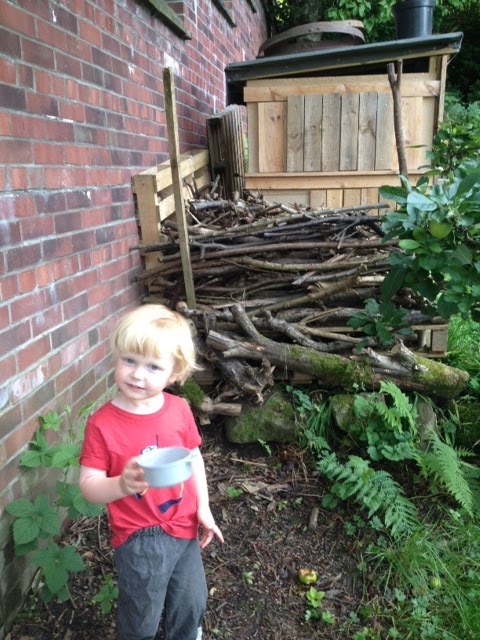
Euan found the perfect location for a spot of seed bombing!
Go enjoy
You can also get outside and see these wildflowers where they grow. There are nearly 50 internationally important sites for wild plants in Scotland known as Important Plant Areas (IPAs). You could look for the native alpine flowers on Ben Lawers and the Breadalbane Mountains above Loch Tay. Or you could explore our Celtic Rainforest (I never knew we had rainforest in Scotland, but I guess it does rain enough!) on the West Coast. But you don’t need to travel far to enjoy native wildflowers, just have a look at the side of the roads near you. More than 550 different wildflowers grow in Scotland’s road verges. Let’s all do a little bit to help our local, native wildflowers.
Take A Walk On The Wild Side…
Do you fancy being a wildlife warden in your own nature reserve? If you go about creating a wildlife garden correctly (and not just leaving a bit of your garden to go wild) you will be rewarded with countless visits by new birds, insects, animals and amphibians. You might even get an increase in crop yield from your veg and fruit. And helping out wildlife doesn’t mean you have to compromise on design either.
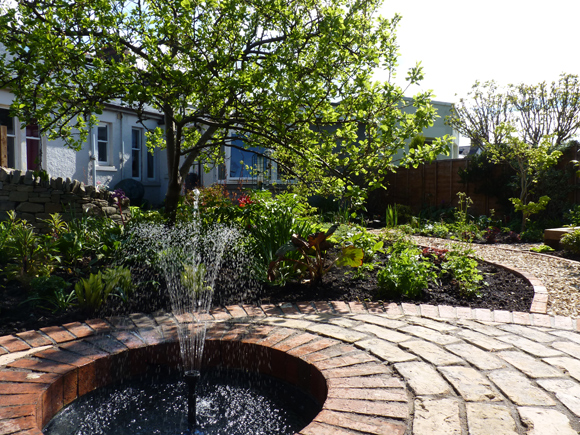
A wildlife garden doesn’t need to compromise on style
Why should we encourage wildlife into our gardens?
Lots of indigenous creatures like hedgehogs, sparrows, stag beetles and song thrushes are continuing to struggle in the UK. But with more than 16 million gardens in the UK, imagine the difference we could make if we all did a little bit more in our gardens to help.
We have recently redesigned the gardens at Jupiter Urban Wildlife Centre for the Scottish Wildlife Trust. It’s been incredibly rewarding seeing how our designs can make a real difference to wildlife on that reclaimed industrial wasteland and look beautiful at the same time. Whether you are thinking of a whole new garden design that centres around wildlife or if you have an area you could designate for them, there are lots of ways you can really make a difference.
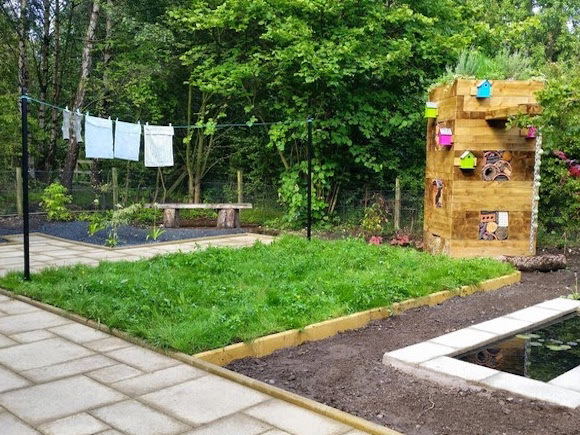
The new Jupiter Urban Wildlife Centre which Vialii designed features funky bug hotels as well as a pond and living walls
Before you embark on your wildlife garden…
If you’re looking at a new garden design, you first need to determine just what you want to use your garden for and who will be using it. Once you have the basic structure of patios, seating areas, paths, veg areas, borders and lawns sorted you can then start thinking about the smaller creatures who also enjoy hanging out in your garden (wildlife that is, hopefully you’ve already thought about children and pets!)
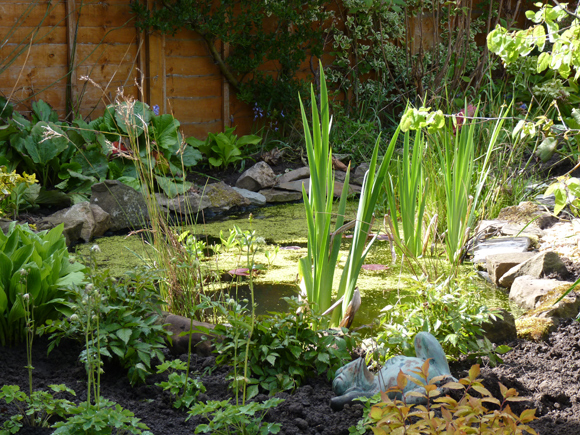
The pond we built in this Edinburgh garden is a haven for wildlife
Things to consider in a wildlife garden
Pond
The single most beneficial item you can introduce in your wildlife garden design is a pond. Ideally don’t add fish as they will eat visiting wildlife which kind of defeats the purpose! Make sure one side of the pond has a more gradual sloping side to allow creatures easy access.
Planting
By being intelligent with the choice of flowers you can provide pollen and nectar for bees, butterflies and other pollinating insects. That has the added benefit of helping with any pollination in your veg and fruit plots. Pick a range of flowers so that nectar and pollen is available from spring (e.g crocuses) through to autumn (e.g. Michaelmas daisies). Also ensure you have a mix of trees and shrubs. Larger trees are great at providing food and shelter for a range of wildlife. Also, 96% of our native wildflower meadows have been lost in the last 60 years so by including one in your garden you can help restore the balance. They are relatively low maintenance and you can even mow a path through it to add intrigue and encourage exploration in your garden design.
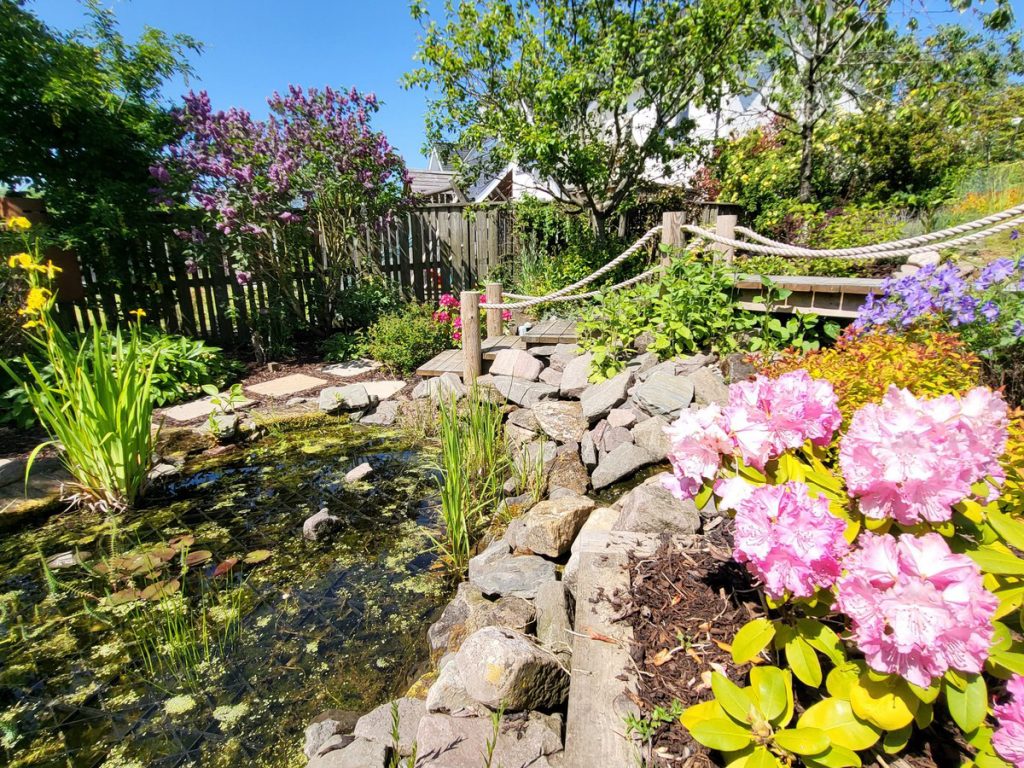
A stunning garden pond we created
Wood piles
Decaying wood is increasingly rare in the countryside so by leaving a pile of dead wood you’ll benefit stag and bark beetles and their grub as well as many fungi. You can be creative with the structure of the pile and can make it look quite architectural or funky.
Create alternative habitats
Another more rustic idea is to make a rock garden that will attract important flying insects such as mason bees. During their 6-8 week life they will help pollinate your fruit trees. They need a source of mud but with our climate in Scotland this is not normally a problem! They also need a shelter. Mason bees’ nesting holes are ideally 5mm diameter and 15cm deep. You can provide paper straws or bamboo tubes in these dimensions and perhaps tuck them in an upturned flowerpot or buy a commercially available option.
Solutions for smaller spaces
If you’re short on space or can’t commit to a complete garden design, you can still help out wildlife. You could plant up a hanging basket with ox-eye daisies, lavender, wild pansies and honeysuckle to encourage bees and butterflies. Or just fill a planter with wildflower seeds rather than having a full meadow area.

The correct planting will help encourage wildlife into your garden
If you hanker after a pond but think you’ve not got the space you could create a pond in a pot. You just need a water tight container – how about up-cycling an old Belfast sink with the hole plugged? Place 2-4cm of peat-free compost in the bottom and cover with gravel. Fill the container with water (rainwater is ideal but if using tap water leave for 2-3 days). Then plant up once the water has cleared. Use oxygenating plants which will survive in water. You can make a little shelf and plant marginals. All you need to do then is keep the water levels topped up (again using rainwater to reduce likelihood of algal blooms) and enjoy the new wildlife.
Think about your boundaries
Another option for a small wildlife garden is to make a functional item such as a fence into a living boundary by covering them with wildlife friendly flowering and berry producing plants. Honeysuckle bark makes good nest building material for birds and the flowers attract a plethora of insects. Clematis plants provide burst of colour for us and attract insects and provide shelter for birds. Ivy is another excellent option as the flowers provide autumn nectar for honey bees and red admiral butterflies, birds love the berries and lots of wildlife can use the plant for shelter.
If you are interested in creating a wildlife garden and need some help, contact us for a free design consultation.
Thanks for reading,
All at Vialii
Going Native (Hedge)…
Hey, Lulu here again! Have you met my parents? M&D are very clever garden designers and they can suggest all sorts of suitable boundaries in your garden – many clients opt for stone walls or one of the many different types of fencing available. But one of my favourite kinds of boundary is a native hedge. Now is the perfect time to plant a new hedge. In this blog I will explain to you why they are so special and how to plant one…
1. Wildlife will love it
There are two main reasons to opt for a native hedge:
Straight away you will see all sort of lovely wildlife visiting your hedge, from small mammals and invertebrates to insects and all sorts of birds making a home there and eating the berries. Butterflies and moths will also come visiting your new boundary.
2. Year round interest
You will have year round interest from foliage, blossom, flowers and berries. Planting a mixed hedge will provide a wide array of foliage which change through the seasons and some shrubs will provide berries and/or flowers to add additional interest throughout the year.
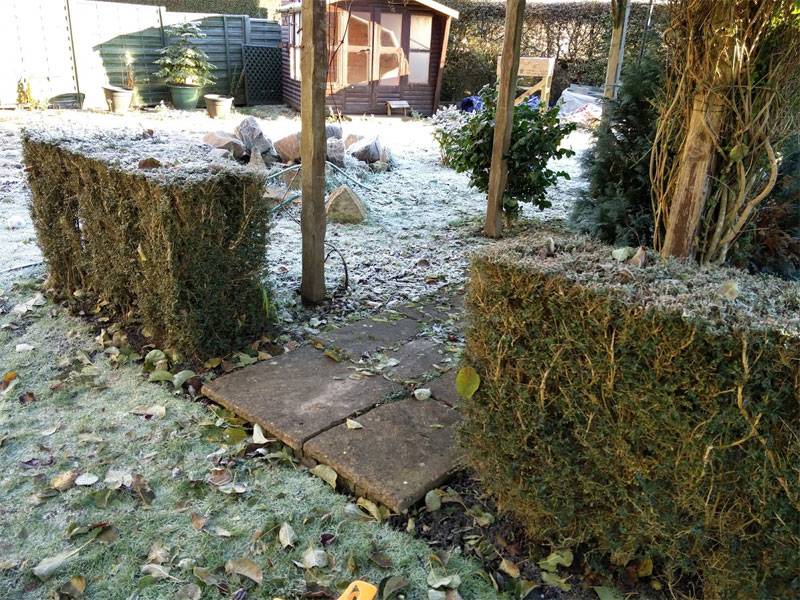
Hedging can provide year round interest
Ilex aquifolium (Holly) – who can forget the wonderful holly, especially at this time of year. We all know its lovely foliage and hungry birds love its berries.Choose a nice mixture of native shrubs and trees such as birch, beech, oak, hazel (for the lovely nuts if you can get there before the squirrel!), dogwoods (for their wonderful red stems in winter) and hawthorn (berrylicious!). Look at adding in some other wonderful species such as:
- Euonymus europaeus (Spindle) A favourite in our own garden, in autumn the leaves turn bright red and are followed by shocking pink and orange fruit.
- Viburnum opulus (Guelder rose) – this shrub will reward you with masses of white flowers in May and June and red berries in autumn.
- Acer campestre (Field maple) Beautiful yellow autumn colour.
- Rhamnus cathartica (Buckthorn) The Buckthorn providesred autumn fruits that turn to black.
- Lonicera periclymenum (Honeysuckle) This will add scent as well as fruit to the mix.
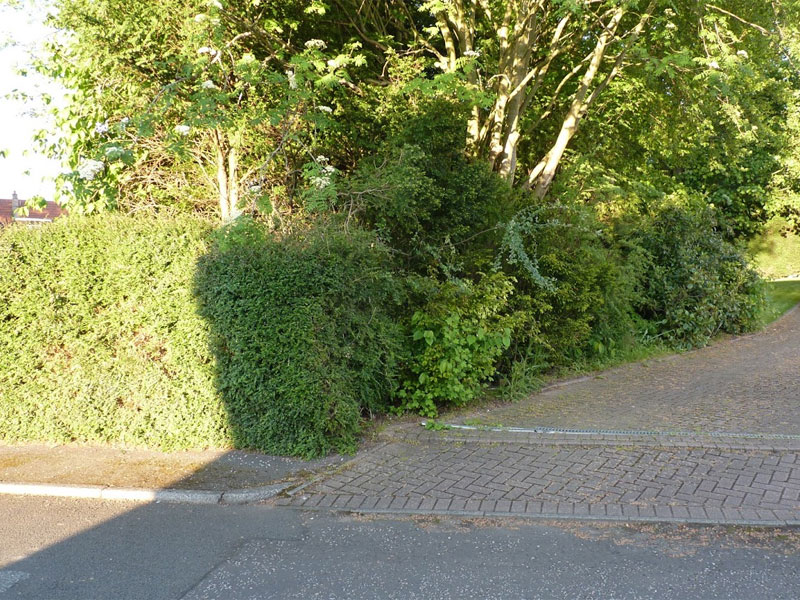
Mixed hedging is wonderful for wildlife
The cheapest way to plant your native hedge is to get “whips” which are available now. Winter is the best time to plant a new hedge. The whips will look teeny and not very impressive when you get them (a bit like sticks) but as soon as Spring arrives they will burst into life and will soon grow quickly. Try and source your hedge locally if possible.
Next, the planting…
Prepare your area and remove any weeds, large stones or debris. Your hedge will be there for many years to come so you need to give it a good start. Dig a trench and add some compost to the bottom then plant your whips in staggered double rows, half a metre apart. You can always fill any gaps later if required. Back fill the trench with the native soil and water well and mulch. Feed your hedge once a year and be aware of dry spells when you may need to water your new hedge over the first couple of years. The best time to prune your hedge is late Autumn when you won’t disturb any nesting birds. If necessary, cut back hard as this will help thicken up your hedge.
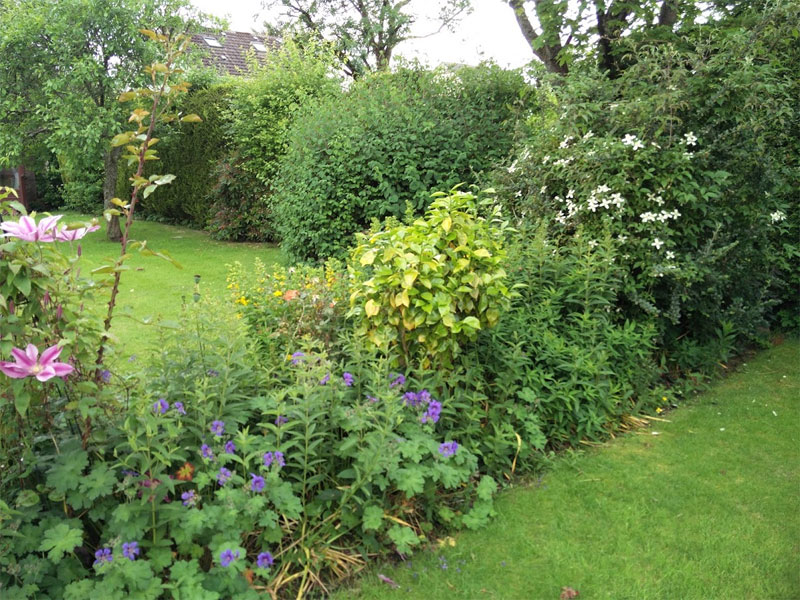
Hedging can be anywhere in your garden, not just the boundary
And remember hedges don’t just need to be used to create boundaries. You can use them within your garden to create “rooms”, add privacy, create journeys and add interest to the garden. Long live the common garden hedge!
If you need any more information on planting a native hedge or any form of boundary in your garden then please don’t hesitate to get in touch for a chat.
Lulu
Save The Snail!
Most gardener’s don’t like snails but I have a confession to make. I, Lulu Ann Burt love them! There, I said it! ‘Nails (as I call them) are funny creatures and I love hunting for them in the garden. I say Save The Snail! Trouble is they love eating the scrummy plants in the garden as much as we do! It’s important to try and help look after our prized plants so here are a few of my top tips on being snail-savvy in the garden as well as a brilliant project to make your own snail which won’t eat any of your prized hostas!
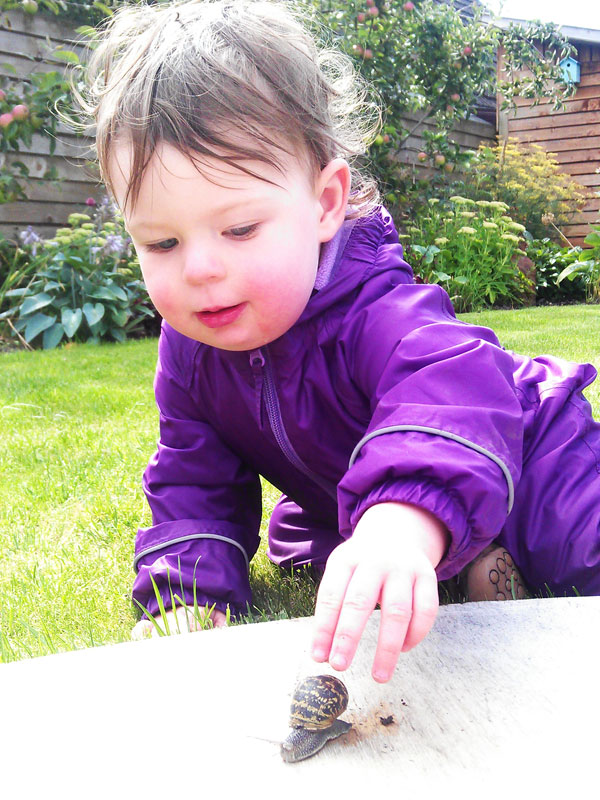
Me and my friend the ‘Nail
As I love snails very much and as M&D feel very strongly about being organic we don’t recommend putting down slug and snail pellets in the garden. These can be eaten by other animals or even children and can be very dangerous (as well as not very nice way to treat my friend the snail!) Here are some better ways to deal with them…
Ooh ooh, ouch!
Snails hate to crawl over anything scratchy so putting a ring of something like crushed egg shells or grit around the plants they most like to eat helps deter them. Watch out for any foliage that falls into the ring as that can be used as a bridge by the canny creatures.
Ring a ring of hostas
If you have your prized plants in pots which the snails are attacking, try putting a copper ring around the pot – the snails won’t want to crawl over it and your plants stay safe.
Snail hunting!
This is my favourite method – snail hunting! Swap your spade for a torch and get out at dusk and collect the pests yourselves. You will be amazed at how many of the wee beasties you will find!
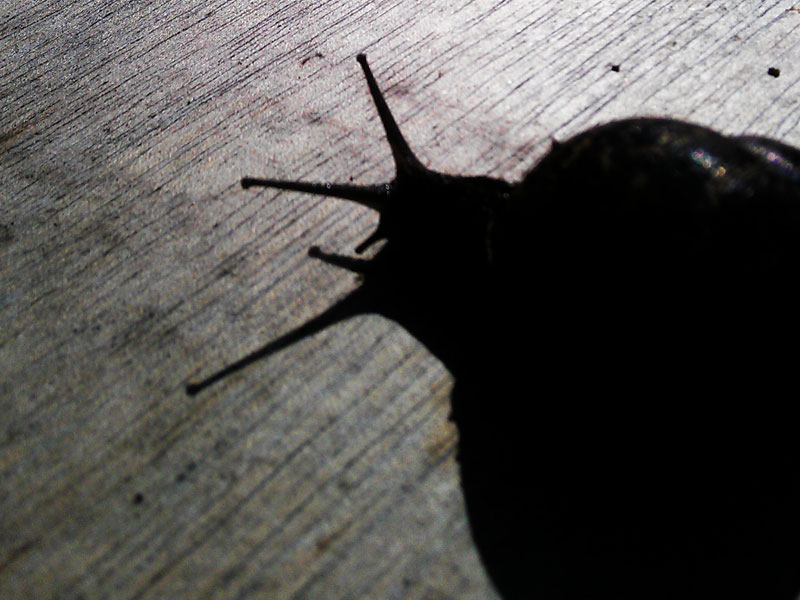
Head out and do some snail hunting at dusk
Pull on the (fox)gloves
Sometimes you need to box clever and choose plants which snails wouldn’t have at their beastly banquet. Choose plants with scented leaves such as alliums, fennel and rosemary, plants with textured leaves such as lambs ears and lavender or plants such as ferns, foxgloves and camellias. All beautiful but relatively safe from unwanted intruders.
Cheers
A method well known in the gardening world is setting beer traps for snails. If your grown-up can spare some of their well earned bottle at the end of a day’s hard graft in the garden, ask them to sink a rinsed out empty can with some beer in it, into the ground. Snails are attracted to the smell and fall in the can and can’t get back out making it easy for you to dispose of them.
Nematodes
Some gardeners turn to a biological solution in the fight against snails. A naturally occurring nematode (a tiny worm) can be introduced into the gardener by adding it to a watering can. They contain bacteria which attacks and kills snails. It lasts for about six weeks and doesn’t affect anything else in the garden. Despite the name no toads are used in this method!
Nema-toads
As you can see there are lots of ways of tackling snails but I think one of the best ways is to attract beneficial wildlife that feasts on snails. If you have space for a wildlife pond you can attract frogs and toads which love a slug supper. Creating a log pile or leaving a corner of old leaves may mean a hedgehog sets up home in your garden and it will repay you by eating up these foe. Or make a bug hotel or encourage birds into the garden to help you in your efforts.
So, now you know how to keep snails out of your garden why not bring one into the house instead with this wonderful craft idea:
Make A Paper Plate Snail
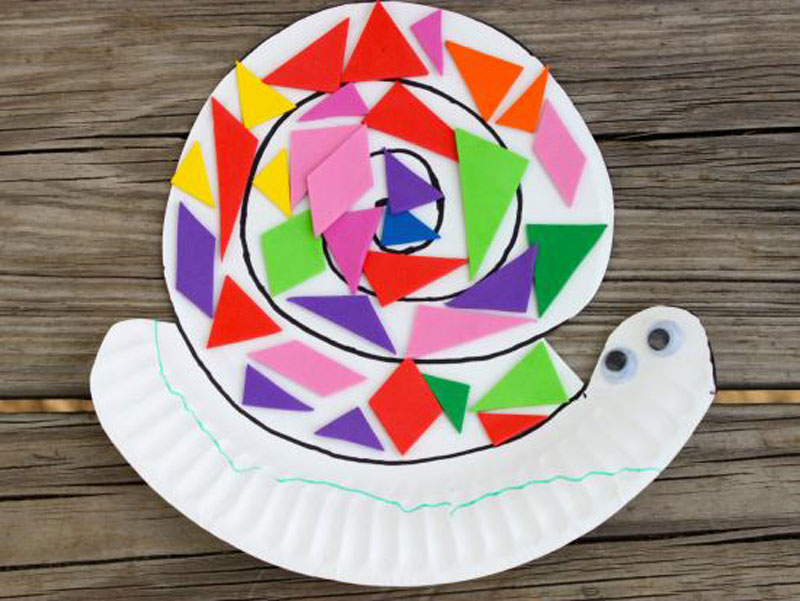
Make A Paper Plate Snail (Image courtesy of Kiwi Co)
You will need:
- A paper plate
- A marker pen
- Scissors
- Coloured paper or stickers
- Glue
- Paint
- Googly eyes (optional)
- Pipe cleaners (optional)
To make:
1. Draw this shape on the paper plate:
2. Cut off the top part of your paper plate to make the snail shape:
3. Use your coloured paper or stickers to stick shapes around the shell. Make your snail as funky and colourful as you wish. I liked learning about the different colours and shapes we were using as we did it
4. Finally paint the body, stick on (or draw on) your eyes and if you wish, add some pipe cleaners to make the feelers. And there you have it – a paper plate snail! All the fun but your hostas will stay safe 😉
You can make themed snails too if you wish. Grandma and I made a lovely festive snail for Christmas!
Remember to email me photos of your snail creations or if there are other garden animals you would like to learn about and see a craft project on then let me know!
For more tips on garden pests visit our blog:
Vialii Guide To Top Garden Pests And Diseases
Lulu
Thank you to Kiwicrate for the inspiration for this craft project
Do You Do Room Service?
Everyone likes a nice, comfy home and bugs are no different from the rest of us. Many are happy to set up home under a pile of leaves or logs. But why not go a step further and create your own bug version of Gleneagles in your very own back garden with a 5 Star Bug Hotel? Here’s how to make a bug hotel…
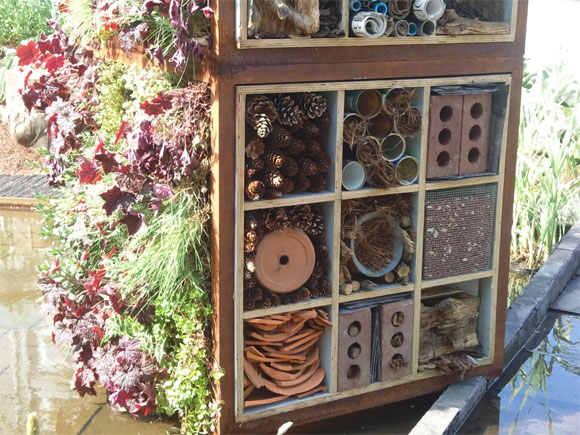
A stunning bug hotel from the Chelsea Flower Show
Many of us like to have a neat and tidy garden and by doing so we often eradicate the natural habitats bugs can call home. Or in a new garden with lots of hard landscaping and container planting there may be limited places for invertebrates to set up home. Bug hotels are purpose built structures which can be as simple or grand as you like.
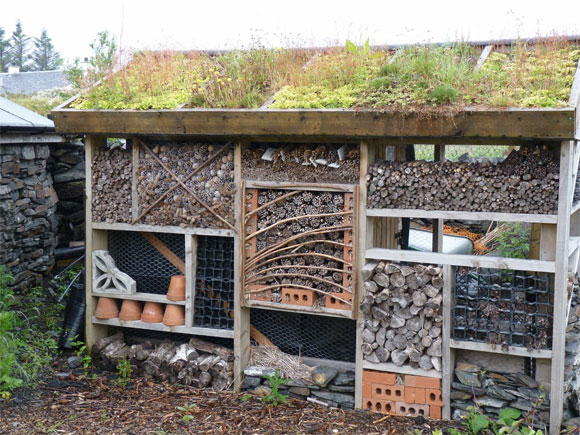
A bug hotel on Seil Island with a green roof
Designing A Bug Hotel
The first rule of creating a bug hotel is to incorporate a variety of materials and different shapes and sizes of nooks and crannies. Different bugs have different requirements so in order to be diverse and encourage as much wildlife as possible into your garden make sure you use a wide array of materials. Offer everything from single rooms up to penthouse suites with a spa thrown in for good measure!
[[image:blog/blog-roomservice-3.jpg=A stunning bug hotel from the Chelsea Flower Show using lots of different materials]]
If you can, do a rough design of what you want your bug hotel to look like. Most bug hotels are made from reclaimed material thus making them cheap and easy to build as well as good for the environment. You could use some old pallets which are easy to get hold of to create the different layers of your bug hotel. Or if you are feeling adventurous you could create a real focal point in your garden by building a tower similar to the fantastic work of art at the Chelsea Flower Show a few years ago.
Building A Bug Hotel
Building a bug hotel is a wonderful project to build with children and you can encourage them to collect the materials you are going to use. Many of these you will have lying around the house and you can ask friends and family to donate to your hotel. Ideal materials include:
- Bamboo canes
- Egg cartons
- Pieces of slate
- Straw
- Logs (drill the ends for even more places for bugs to set up home)
- Broken terracotta pots
- Old bricks
- Old roof tiles
Pack the various materials into different sections of your “hotel” and soon you will have created a home which looks interesting and will have wide appeal.
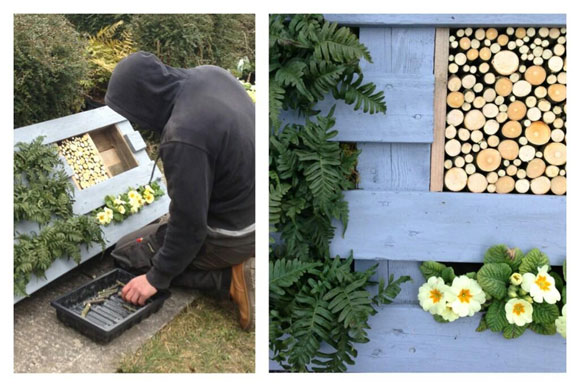
A pallet incorporating a bug hotel at RHS Cardiff Show
Bug Central
So what sort of bugs might pack their bags and move into their new home? Well , common sights include mason bees, woodlice, ladybirds, spiders, beetles and centipedes. By encouraging these bugs into your garden they will help you combat the pests which eat your plants and ruin your grass. Great guests to have and ones which always be welcome back! Wonder if you get Trip Advisor for beetles…
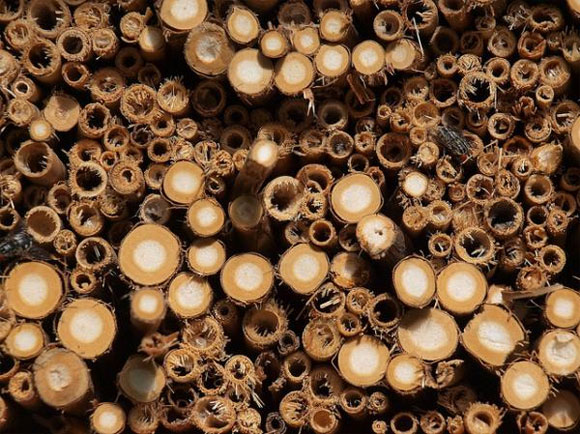
Lots of bamboo canes make an ideal home
If you want advice on building a bug hotel or other ways of turning your garden into a haven for wildlife please get in touch.
For more information on making your own bug hotel please visit our blogs Make Your Own Bug Hotel and How To Make A Bug Hotel.
All at Vialii